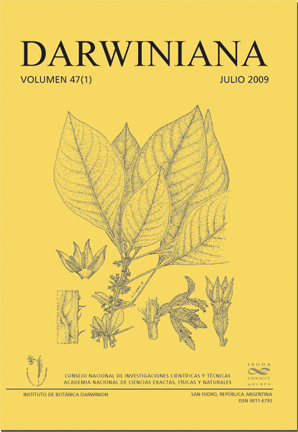Racial variability in archaeological macrorremains of Zea mays (Poaceae) and its connections with the agropastoralism process in Southern Argentine Puna (Antofagasta de la Sierra, Catamarca)
DOI:
https://doi.org/10.14522/darwiniana.2014.471.42Keywords:
Agricultural intensification, archaeobotany, Zea maysAbstract
This paper analyzes the Zea mays racial variability and their relationship with the greater emphasis put on agricultural practices in the Southern Argentine “Puna” during ca. 1300-700 years BP, taking in account the archaeobotanical record of the sites “Cueva Cacao 1A” and “Bajo del Coypar II” (“Antofagasta de la Sierra”, Catamarca, Argentina). Eight maize races were identified: Pisincho, Morocho, Morocho amarillo, Marrón, Harinoso Amarillo, Capia, Culli and Chullpi. This high biodiversity is a clear exponent about the introduction process of multiple maize races in the region. This process would have begun between the end of Formative Period in any moment among 1300 and 1000 years BP and becoming stronger in later moments.Downloads
Published
31-07-2009
How to Cite
Oliszewski, N., & Olivera, D. E. (2009). Racial variability in archaeological macrorremains of Zea mays (Poaceae) and its connections with the agropastoralism process in Southern Argentine Puna (Antofagasta de la Sierra, Catamarca). Darwiniana, Nueva Serie, 47(1), 76–91. https://doi.org/10.14522/darwiniana.2014.471.42
Issue
Section
Archeobotany and Ethnobotany
License

Starting on 2012, Darwiniana Nueva Serie uses Licencia Creative Commons Atribución-NoComercial 2.5 Argentina .






